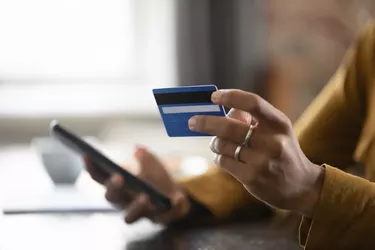
If you have an American Express credit card, you should familiarize yourself with how it works before trying to make a purchase. You will likely notice quite a few numbers on your card, from the credit card number itself to the expiration date to something called the CVV code, American Express explains. This CVV number will be needed for many purchases completed online or by phone, and this method of authentication is an important security feature. You should never tell anyone else your credit card information, including your credit card CVV.
What Is a CVV?
Video of the Day
CVV stands for card verification value (sometimes also called a card verification value code). It is a three- or four-digit number that is typically found embossed or imprinted on the back of your credit card. It is three digits on Visa, MasterCard and Discover credit and debit cards. On American Express cards, the CVV is a four-digit number located on the front of the card.
Video of the Day
The CVV is used to verify that you actually have the physical credit card in your possession when making online or over-the-phone purchases. This helps to prevent fraud and protects businesses from chargebacks. When providing your Amex card's CVV for validation, you should always make sure that the website or company you are dealing with is legitimate and that your connection is secure. This will help to prevent credit card fraud.
Safety and CVVs
If you are ever asked for your CVV when making a purchase in person, you should be suspicious, as this is not a common practice. You should never give your CVV to anyone whom you do not know and trust. If you are ever in doubt, you can always call the customer service number on the back of your card to verify that the request is legitimate.
You will usually be asked to provide your CVV when you are making a purchase online. This is normal, and it's OK to provide the number in these scenarios. If you forget where your CVV is located, many websites have a button you click for help during the checkout process. It often looks like the "i" used to signify "information" and may be located next to the box where you enter your CVV. It may also say "what's this?" It will explain where to find your CVV and where to find your card account number.
Tips for American Express Cards
What else should you know about using an American Express card?
- American Express also refers to the CVV as a "card identification number" (CID). If you hear a representative use this term, you can feel confident that they are still talking about a CVV.
- When making online or over-the-phone purchases with an American Express card, you may be asked to provide additional information, such as your card number, expiration date, and CVV all in one go. This is called a card security code full authorization request, and it's designed to help prevent fraudsters from gaining and using your information.
- Be sure to sign your name in the signature panel as soon as you receive your card. If someone other than the cardholder ever gains access to your physical card, they theoretically should have a harder time using it if their signature doesn't match.
- If you ever notice that you have a card not present in your wallet, call the phone number for your credit card company immediately (or check the customer service website, like this one for American Express) to report it.
American Express Card Billing Cycles
Finally, it's important to know that American Express cards have different billing cycles than other credit cards. With American Express, you will be billed once a month instead of every 28 days like with most other issuers. This means that your payment due date may not always fall on the same day each month.
If you are unsure when a payment is due, be sure to check with American Express to get assistance. You should call the phone number on the back of the card anytime you need to reach out to customer service. You should never contact a credit card issuer via a number you find online unless you can be absolutely certain it's the company's official website.